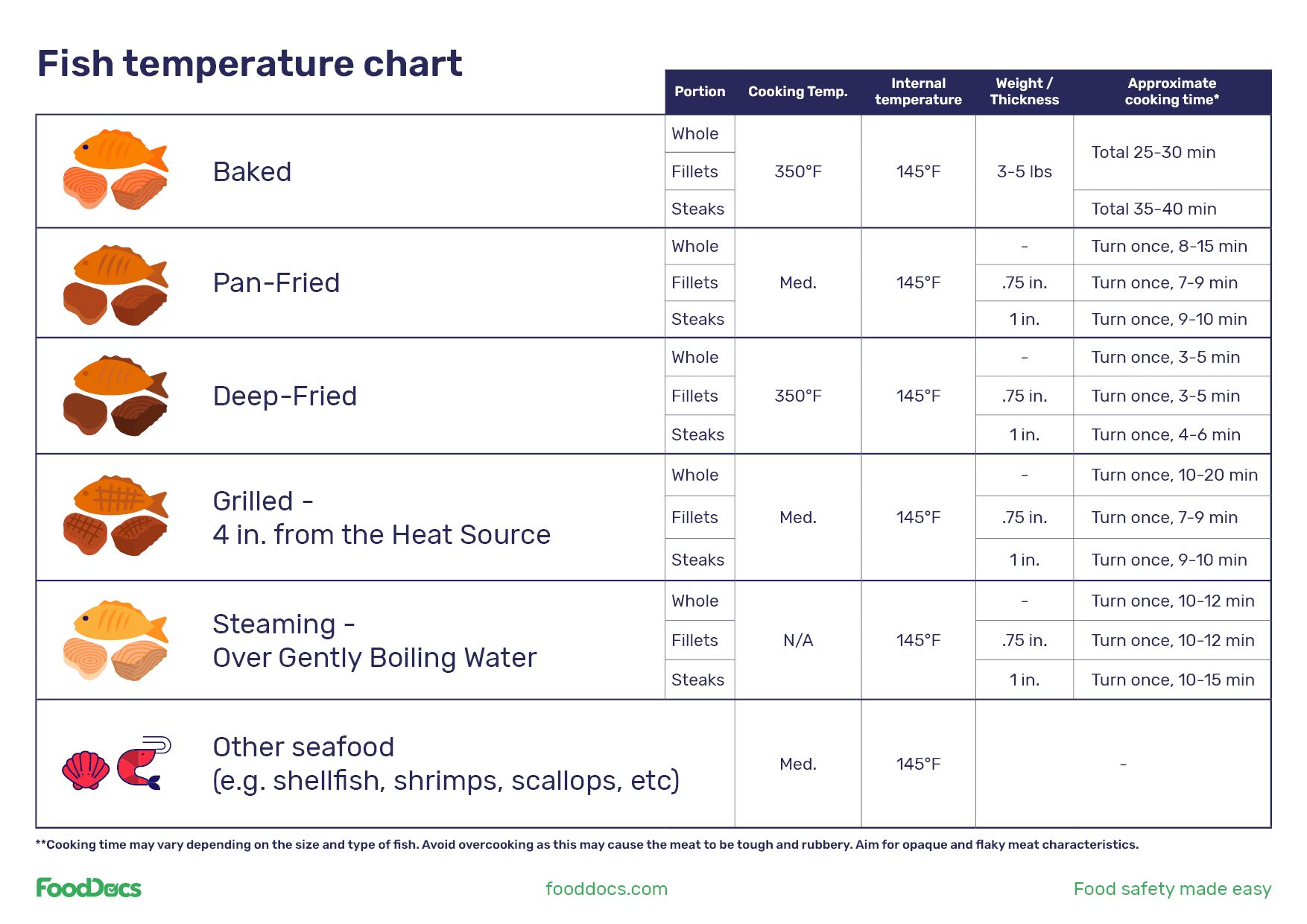The FDA recommends cooking fish to an internal temperature of 145°F (63°C). At this temperature, fish is fully cooked and safe to eat.
Know More About: what temperature should fish be cooked to
Best Temperature to Cook Fish: Achieve Perfection Every Time
Cooking fish can be a delicate endeavor, requiring precision and attention to detail. To ensure your fish is cooked to perfection, it’s important to understand the ideal temperature at which different types of fish should be cooked. Whether you’re preparing a succulent salmon fillet or a delicate white fish, getting the temperature right is the key to unlocking its true flavors and textures. In this article, we will explore the perfect temperatures for cooking various types of fish, helping you achieve outstanding results in your culinary adventures.
1. Salmon: For many fish enthusiasts, salmon stands as the king of seafood. Its rich and buttery texture, along with its distinctive flavors, make it a favorite for different preparations. When it comes to cooking salmon, aim for a temperature between 120°F and 145°F (49°C to 63°C) to achieve the desired doneness. At 120°F (49°C), the fish will be rare, exhibiting a melt-in-your-mouth tenderness. Boosting the temperature to around 145°F (63°C) will give you a medium-well to well-done fillet, delivering a firmer texture and more pronounced flavors.
2. White Fish: Varieties such as cod, haddock, and sole are considered delicate white fish that require specific care during cooking. To retain the tender and flaky texture of these fish, cook them at a moderately low temperature, between 135°F and 140°F (57°C to 60°C). This cooking method ensures that the white fish remains moist and doesn’t dry out, resulting in a delectable dish that retains its moisture and natural flavors.
3. Tuna: For those who enjoy a meatier fish, tuna is an excellent choice. Whether seared, grilled, or baked, tuna should be cooked at a higher temperature to achieve the desired outcome. A temperature range of 135°F to 150°F (57°C to 66°C) is recommended for tuna. This will retain its pink color and provide a medium to medium-well texture, giving you a juicy and flavorsome eating experience.
4. Halibut: Known for its firm and meaty texture, halibut is a popular choice among seafood lovers. To maintain its mild sweetness and avoid a dry texture, aim for a temperature between 125°F and 130°F (52°C to 54°C). This will ensure a gently cooked halibut fillet, resulting in a moist and tender bite.
5. Shellfish: Whether it’s shrimp, lobster, or scallops, shellfish present a unique culinary experience. To safely cook shellfish, a temperature of 145°F (63°C) is recommended. This temperature will ensure that any harmful bacteria living in the shellfish are killed, guaranteeing a safe and healthy meal.
When cooking fish, the use of an accurate food thermometer is highly recommended. This kitchen tool will provide precise readings and remove any guesswork, allowing you to achieve consistent results every time. Remember to insert the thermometer into the thickest part of the fish without touching the bone, to get an accurate temperature reading.
Now armed with the knowledge of the best temperatures for different types of fish, you can approach your future culinary endeavors with confidence and finesse. Cooking fish to perfection not only ensures a delightful meal, but it also enhances the natural flavors and textures of the seafood, leaving a lasting impression on your taste buds. With these temperature guidelines, embark on your seafood cooking adventures and savor the incredible flavors that the ocean has to offer!
FAQs on what temperature should fish be cooked to
1. What is the ideal temperature to cook fish?
Fish should be cooked to an internal temperature of 145°F (63°C) to ensure it is safe to eat and to maintain its quality.
2. How can I check the internal temperature of the fish?
You can use a digital meat thermometer inserted into the thickest part of the fish to accurately measure its internal temperature.
3. Is there a difference in cooking temperature for different types of fish?
No, the recommended cooking temperature of 145°F applies to most types of fish, including salmon, cod, tilapia, and grouper.
4. What if I prefer my fish less cooked or slightly undercooked?
While it is important to cook fish to a minimum temperature of 145°F for safety reasons, some people may prefer a slightly more tender texture or medium-rare preparation. However, it is essential to ensure that the fish is fresh, and the internal temperature reaches at least 145°F to minimize the risk of foodborne illnesses.
5. Can I cook fish to a higher temperature for well-done results?
Yes, if you prefer your fish well done, you can cook it to a higher internal temperature, but exceeding 145°F may cause the fish to become dry and lose its natural tenderness.
6. What happens if I overcook fish?
Overcooking fish can result in a dry and tough texture, making it less enjoyable to eat. It is best to follow the recommended cooking temperature and keep a close eye on the fish while cooking to avoid overcooking it.
7. Can I cook frozen fish to the same temperature?
Yes, the recommended internal temperature of 145°F also applies to frozen fish. It may take slightly longer to cook than fresh fish, so make sure to check the internal temperature using a meat thermometer before considering it fully cooked.
8. Are there any exceptions to the 145°F cooking temperature?
Fish used in sushi or sashimi preparations may not require cooking and can be consumed raw. However, it is crucial to use high-quality, sashimi-grade fish that has been properly handled and stored.
9. What should I do if I am uncertain whether my fish is fully cooked?
If you are unsure about the fish’s doneness, it is always better to err on the side of caution and cook it a little longer to ensure safety and quality. Checking the internal temperature using a thermometer is the most reliable way to confirm the fish is cooked through.
10. Can I rely solely on the color or texture of the fish to determine if it’s cooked?
While the color and texture of the fish can provide some indication of its doneness, these factors may not be completely reliable. Therefore, it is recommended to use a meat thermometer to check the internal temperature for accurate results.

